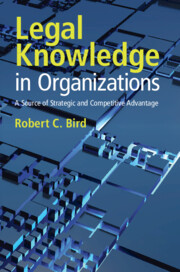Book contents
- Legal Knowledge in Organizations
- Legal Knowledge in Organizations
- Copyright page
- Dedication
- Contents
- Figures
- Tables
- Foreword
- Preface
- Acknowledgments
- 1 Introduction
- 2 Legal Knowledge in Organizations
- 3 Factors That Influence Legal Knowledge Acquisition
- 4 Legal Knowledge in Competitive Environments
- 5 Legal Knowledge in Competitive Environments
- 6 Applications of Legal Knowledge
- 7 Strategic Legal Risk Management
- 8 Strategic Legal Risk Management
- 9 Leveraging Contractual Knowledge to Create and Preserve Value
- 10 Building an Ethical Culture of Legal Knowledge
- Index
4 - Legal Knowledge in Competitive Environments
Avoidance, Compliance, and Prevention Pathways
Published online by Cambridge University Press: 15 March 2025
- Legal Knowledge in Organizations
- Legal Knowledge in Organizations
- Copyright page
- Dedication
- Contents
- Figures
- Tables
- Foreword
- Preface
- Acknowledgments
- 1 Introduction
- 2 Legal Knowledge in Organizations
- 3 Factors That Influence Legal Knowledge Acquisition
- 4 Legal Knowledge in Competitive Environments
- 5 Legal Knowledge in Competitive Environments
- 6 Applications of Legal Knowledge
- 7 Strategic Legal Risk Management
- 8 Strategic Legal Risk Management
- 9 Leveraging Contractual Knowledge to Create and Preserve Value
- 10 Building an Ethical Culture of Legal Knowledge
- Index
Summary
Executives, managers, and employees use legal knowledge with varying levels of sophistication which I term "pathways of legal strategy." There are five discrete pathways of legal strategy that firms use in their legal environment of business. The avoidance pathway focuses on circumvention of legal rules. Firms practicing conformance seek minimum compliance with legal obligations. Prevention firms apply business knowledge to avert legal wrongdoing. Value firms leverage legal knowledge to create and capture value. Firms pursuing a transformation strategy use legal knowledge to redefine the organization or an industry. Each of these pathways is analyzed for its distinct traits regarding the manager’s perception of the law, the level of legal knowledge in the organization, and the role of legal experts, and the pathway’s reinforcement of organizational goals. The pathways can help organizations identify strategic uses of legal knowledge, highlight any mismatches, and develop a clear trajectory in order to shift from one pathway to another. The first three pathways (avoidance, conformance, and prevention) will be addressed in this chapter.
Keywords
- Type
- Chapter
- Information
- Legal Knowledge in OrganizationsA Source of Strategic and Competitive Advantage, pp. 57 - 85Publisher: Cambridge University PressPrint publication year: 2025

